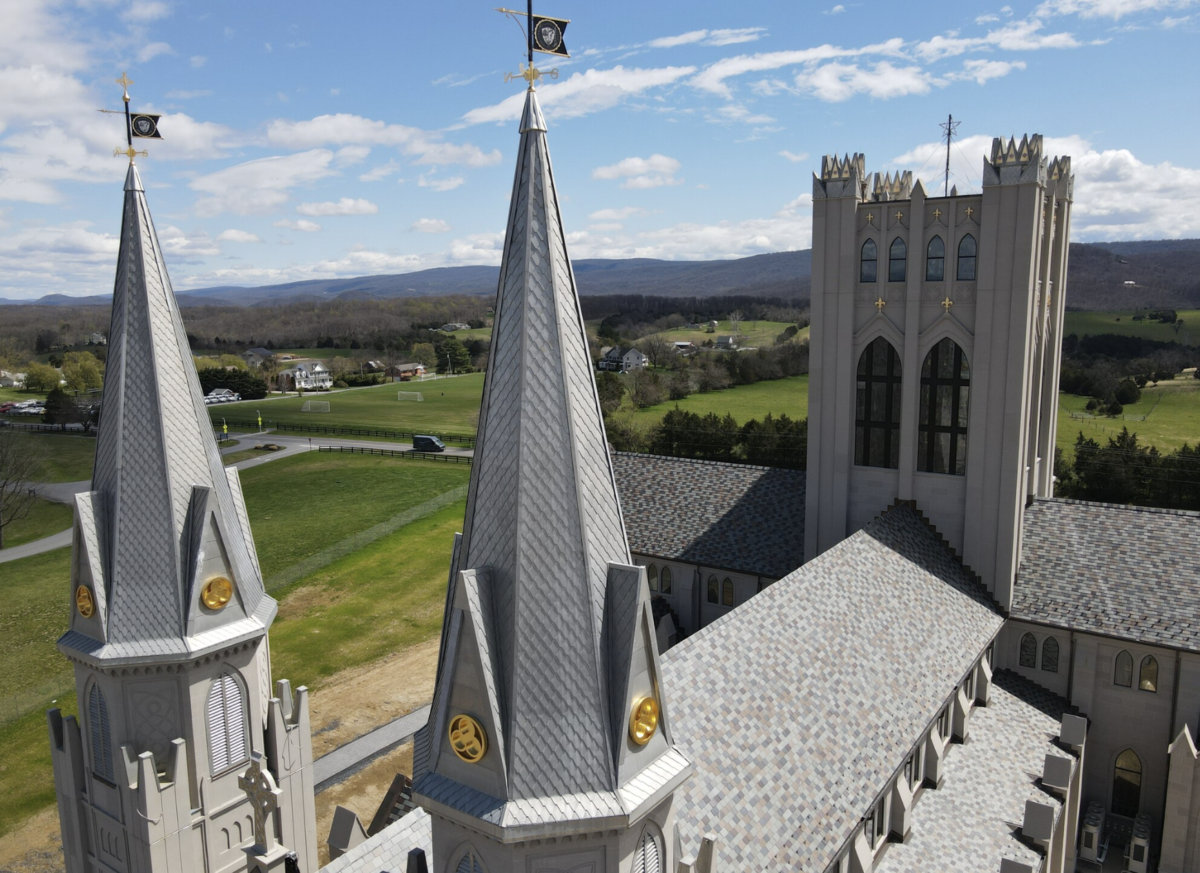On April 15, 2023, Christendom College is scheduled to dedicate its new Christ the King Chapel as part of the college’s 45th anniversary celebration in Front Royal, Virginia. The chapel is an ambitious new construction project inspired by the Gothic cathedrals of Europe.
The design and construction team working alongside the college included architecture firm O’Brien & Keane, general contractor Hoar Construction, and roofing contractor Baker Roofing Company. The team originally explored plans for a metal roof system but decided there was just one choice for the chapel’s roof: traditional slate.
Robert M. Allen, operations manager of the Specialty Steep Slope Department at Baker Roofing, believes his company was tailor-made for this project. “We’ve been in business since 1915, and we have a proven track record of doing this type of work and doing it successfully,” he says. “We do a lot of high-end, very marketable niche specialty projects. The majority of our slate work involves renovations on churches and college campuses. New construction is a smaller market, again mostly churches and colleges. The reason they specify slate is simply longevity. They want to put a roof on that will last 80 years, 100 years, 150 years — and not worry about it. That’s the intent when they go with such a high-end product.”
The Roof System
The roof scope consisted of two layers of 2.6-inch Atlas polyiso insulation, 3/4-inch fire rated plywood, and FT Synthetics Cobalt Ultra underlayment. The 18-inch by 1/4-inch slates in random widths were supplied by Vermont Slate. The roof features a random blend of four colors: Purple, Spanish Black, Unfading Gray/Green, and Semi-Weathering Gray/Green.

Twenty-ounce copper was used for all through-wall flashings, roof flashings, copings, gutters, downspouts and conductor heads. Copper snow guards manufactured by Berger were also installed.
Challenges facing Baker Roofing on the project included logistics, inclement weather, and coordinating with other trades, as well as scheduling travel for crews on the project. Baker Roofing has offices in Virginia, Tennessee, North Carolina, South Carolina, Alabama and Florida, but the Specialty Steep Slope Department operates out of the company’s Raleigh, North Carolina headquarters.
“We went back and forth on a weekly basis,” notes Allen. “We were up there Monday through Friday, weather permitting. The foremost challenge of doing what we do is scheduling based on weather conditions. On-site scheduling and coordination, that just comes with any job. It certainly has its challenges, but any time you are traveling out of state for a project, it definitely throws in a whole different mix of variables to consider when planning and scheduling.”
Work on the project began in March of 2020, and supply chain issues due to the pandemic were a concern. “Material shortages were kicking in and lead times were getting longer, so we really hit this thing on the front end and were able to get our material shipped on time by getting our orders in really early, scheduling our deliveries and getting our P.O.’s cut.”
The spring weather was difficult to predict. “We still had snow up there when we began, and there was a lot of rain throughout the spring,” Allen says. “It was tough to keep everything dry. We had insulation and our nail base assembly going on, and that stuff generally has to stay dry. Anything that we put down for the nail base has got to be 100 percent dried in, covered and weathertight. If we were seeing rain in the forecast, for example, we might limit our production and go for 15 squares instead of 18.”
The Slate Installation
Crews began by mechanically attaching the insulation and plywood to the corrugated metal deck. “We used about 25 screws per 4-by-8 sheet,” Allen says. “The self-adhered FT Synthetics Cobalt Ultra was installed over the plywood.”

The pre-punched slates were installed in the traditional fashion, with two copper nails per slate. Making sure the colors were perfectly blended was crucial. “We had skids of each color, and we had to wait for all of the colors to arrive. Then we started to break down the pallets and blend the colors based on the percentages for the job,” Allen explains. “We’d just do the math and get the proper ratio of the appropriate colors in each two-square pallet. Then we would just pick and choose colors and widths to get a random effect. We had to really figure out how that blend was going to go. You generally don’t see that many colors in a slate roof.”
“You can do patterns in slate, of course, but the intent here was to have it be randomly blended,” Allen continues. “In that case, you don’t want to fall into repetitive patterns. In the first few days, we’d call up or radio up from the ground to make changes in some areas. I might say, ‘Put a purple in now,’ or ‘Put in a black.’ The process was pretty flawless after that, but it took us three or four days to get that blend really dialed in.”
Allen credits his seasoned crews for the company’s quality workmanship. “We specialize in slate,” he says. “It’s definitely one of the more difficult materials to handle. It’s heavy. It’s a long-term product, but if you drop it, it might break. It’s not for everybody. There are special tools for cutting and special hammers for installing slate. It’s a natural stone, and as natural product, it can have its flaws — some not visible to the eye. You can tap on it with the hammer, and if you hear a dead sound, we put those slates off to the side. We’re looking for a nice little ring, and the experienced crews that we work with know what that sound is that tells us it’s a good solid slate to secure to the building.”
Hand tools from John Stortz and Son were used to cut individual slates as needed to fit them in areas including adjacent walls and valleys, as well as the scalloped slates on a diamond-shaped custom design on the outer section of a five-sided hip roof.
“The pastor came up to us about midway through the project and said he had two small pieces of slate from an old church in Ireland, and he wanted to see if we could incorporate them into the building,” Allen recalls. “I went back and started drafting up some ideas and some designs. We came up with the diamond design using colors including black and purple, because we thought it would pop more. The pastor had the pieces of broken slate wrapped in gold leaf, and we placed them at the center.”
Metal Details
The church also features two zinc-coated copper towers, which were supplied fully built and lifted into place. “That was not in our scope of work,” notes Allen. “They came in on semitrucks and were craned into position by the general contractor.”

Baker Roofing fabricated all of the copper gutters, downspouts and flashings on the project. “We have a full-service sheet metal shop in our Raleigh branch, and we sell to the public and also self-fabricate 99 percent of our metal used in projects — companywide,” Allen says.
The through-wall flashings were especially challenging, as the exterior skin of the building was comprised of an exterior insulation finishing system (EIFS). “The EIFS has different widths coming off the wall to create a 3D look,” Allen notes. “Our through-wall flashing had to line up with every one of those crests where the thickness varied. We had to create that same pattern to match with the horizontal and vertical steps that make it look like stone. It took a lot of coordination between our group, the EIFS group, and the architect to make it work. It was very challenging, because we had to put our flashing in first. We had to follow their plans and know all of those thicknesses on the walls. There was a lot of looking things up, checking the drawings and verifying the profiles.
Safety
The safety plan required workers on the roof to be tied off 100 percent of the time. “We accessed the roof via man lifts,” Allen says. “We would boom up, and we had to be harnessed in and attached to the basket. We would egress from the basket to the roof, hooking up to a 50-foot lifeline with our full-body harnesses. We utilized jacks and boards on the roof to give us work stations, if you will. We also had barricades set up where we were working in case any slates should fall.”
Workers below also had to be protected, and movement on the ground was carefully restricted. “We kept all of the other trades away from our working areas,” Allen says. “We had to be mindful of doors and exits and put in overhead protection in those areas. Gravity is our worst enemy in the roofing industry, especially in sloped roofing like this. If you drop a hammer or a tape measure, it’s going to go down, and if somebody happens to walk out at the wrong time, they could get hit. That’s why we set up barricades 30 feet from the perimeter of the building in any areas we were working and limited anyone from entering those areas to avoid any possible incidents. There’s also a lot of training that goes in on the safety side to make sure this all happens — as there should be.”
Earning Trust
Allen credits the success of the project to the professionalism and coordination of the representatives of Christendom College and all of the companies involved in the project.
“Again, this goes all the way back to the design stage,” Allen notes. “The building was originally designed for a metal roof — a modern aluminum standing seam roof. There were some ideas of maybe going with slate, and we flew up there with Frank Baker, vice chairman of Baker Roofing. We met with the design team and the GC and walked out of that meeting with a change order to turn it into a slate project versus a metal job.”
Each successful project builds trust, according to Allen. “Those that know our name and who have worked with us in the past are continued customers because of that ongoing relationship and the proven ability to get things done and do it right,” he says.
“Not a lot of companies have been in business as long as we have while operating at such a high-capacity level. That gives people peace of mind. The warranty that we give them at the end if the job is more than just a piece of paper because we are going to be here for another 100 years to service you should you need to call us. I think that really hits home with people, whether it’s a homeowner with a basic reroof project or a building owner with a higher-end, commercial-based project.”
TEAM:
Architect: O’Brien and Keane Architecture, Arlington, Virginia, obrienandkeane.com
General Contractor: Hoar Construction, Birmingham, Alabama, hoar.com
Roofing Contractor: Baker Roofing Company, Raleigh, North Carolina, bakerroofing.com
MATERIALS
Slate: Vermont Slate Company, vermontslateco.com
Underlayment: Cobalt Ultra, FT Synthetics, ftsyn.com
Insulation: Polyisocyanurate, Atlas Roof & Wall Insulation, atlasrwi.com





Be the first to comment on "Christendom College’s New Christ the King Chapel Chapel Features Traditional Slate Roof"